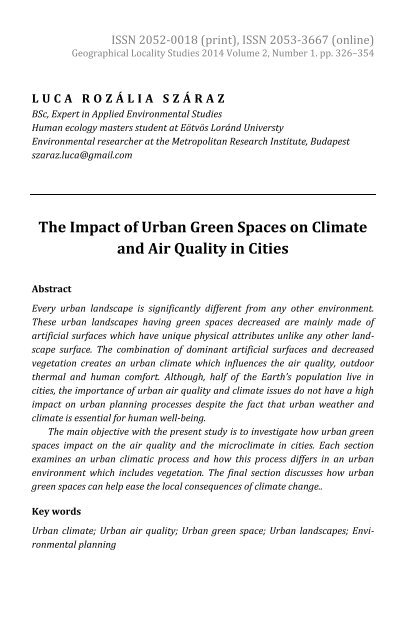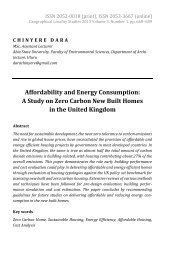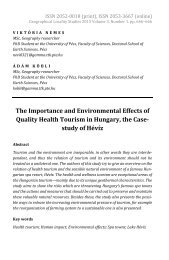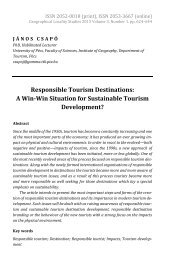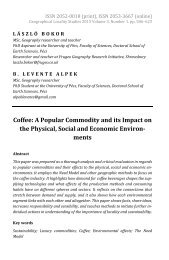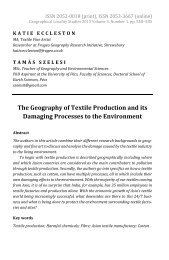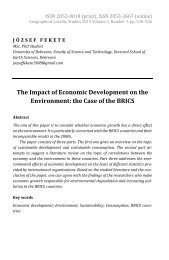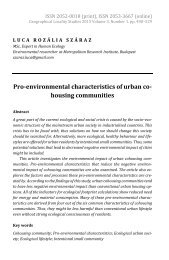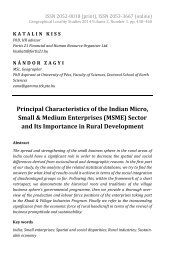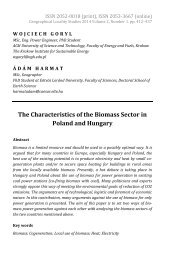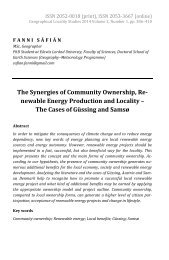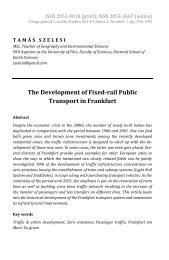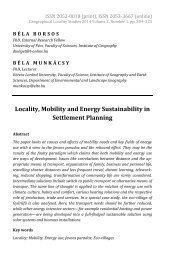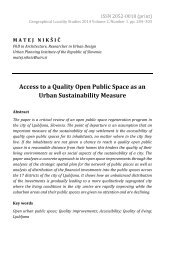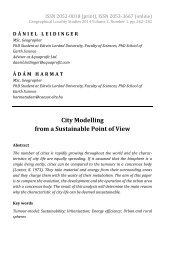Luca Rozália Száraz: The Impact of Urban Green Spaces on Climate and Air Quality in Cities
The main objective with the present study is to investigate how urban green spaces impact on the air quality and the microclimate in cities. Each section examines an urban climatic process and how it differs in an urban environment which includes vegetation. It also discusses how urban green spaces can help ease the local consequences of climate change.
The main objective with the present study is to investigate how urban green spaces impact on the air quality and the microclimate in cities. Each section examines an urban climatic process and how it differs in an urban environment which includes vegetation. It also discusses how urban green spaces can help ease the local consequences of climate change.
You also want an ePaper? Increase the reach of your titles
YUMPU automatically turns print PDFs into web optimized ePapers that Google loves.
LUCA ROZÁLIA SZÁRAZ<br />
BSc, Expert <strong>in</strong> Applied Envir<strong>on</strong>mental Studies<br />
Human ecology masters student at Eötvös Loránd Universty<br />
Envir<strong>on</strong>mental researcher at the Metropolitan Research Institute, Budapest<br />
szaraz.luca@gmail.com<br />
<br />
<br />
<str<strong>on</strong>g>The</str<strong>on</strong>g> <str<strong>on</strong>g>Impact</str<strong>on</strong>g> <str<strong>on</strong>g>of</str<strong>on</strong>g> <str<strong>on</strong>g>Urban</str<strong>on</strong>g> <str<strong>on</strong>g>Green</str<strong>on</strong>g> <str<strong>on</strong>g>Spaces</str<strong>on</strong>g> <strong>on</strong> <strong>Climate</strong><br />
<strong>and</strong> <strong>Air</strong> <strong>Quality</strong> <strong>in</strong> <strong>Cities</strong><br />
Abstract<br />
Every urban l<strong>and</strong>scape is significantly different from any other envir<strong>on</strong>ment.<br />
<str<strong>on</strong>g>The</str<strong>on</strong>g>se urban l<strong>and</strong>scapes hav<strong>in</strong>g green spaces decreased are ma<strong>in</strong>ly made <str<strong>on</strong>g>of</str<strong>on</strong>g><br />
artificial surfaces which have unique physical attributes unlike any other l<strong>and</strong>scape<br />
surface. <str<strong>on</strong>g>The</str<strong>on</strong>g> comb<strong>in</strong>ati<strong>on</strong> <str<strong>on</strong>g>of</str<strong>on</strong>g> dom<strong>in</strong>ant artificial surfaces <strong>and</strong> decreased<br />
vegetati<strong>on</strong> creates an urban climate which <strong>in</strong>fluences the air quality, outdoor<br />
thermal <strong>and</strong> human comfort. Although, half <str<strong>on</strong>g>of</str<strong>on</strong>g> the Earth’s populati<strong>on</strong> live <strong>in</strong><br />
cities, the importance <str<strong>on</strong>g>of</str<strong>on</strong>g> urban air quality <strong>and</strong> climate issues do not have a high<br />
impact <strong>on</strong> urban plann<strong>in</strong>g processes despite the fact that urban weather <strong>and</strong><br />
climate is essential for human well-be<strong>in</strong>g.<br />
<str<strong>on</strong>g>The</str<strong>on</strong>g> ma<strong>in</strong> objective with the present study is to <strong>in</strong>vestigate how urban green<br />
spaces impact <strong>on</strong> the air quality <strong>and</strong> the microclimate <strong>in</strong> cities. Each secti<strong>on</strong><br />
exam<strong>in</strong>es an urban climatic process <strong>and</strong> how this process differs <strong>in</strong> an urban<br />
envir<strong>on</strong>ment which <strong>in</strong>cludes vegetati<strong>on</strong>. <str<strong>on</strong>g>The</str<strong>on</strong>g> f<strong>in</strong>al secti<strong>on</strong> discusses how urban<br />
green spaces can help ease the local c<strong>on</strong>sequences <str<strong>on</strong>g>of</str<strong>on</strong>g> climate change..<br />
Key words<br />
<str<strong>on</strong>g>Urban</str<strong>on</strong>g> climate; <str<strong>on</strong>g>Urban</str<strong>on</strong>g> air quality; <str<strong>on</strong>g>Urban</str<strong>on</strong>g> green space; <str<strong>on</strong>g>Urban</str<strong>on</strong>g> l<strong>and</strong>scapes; Envir<strong>on</strong>mental<br />
plann<strong>in</strong>g
1. Introducti<strong>on</strong><br />
<br />
<br />
et<br />
al.<br />
<br />
<br />
et al.<br />
<br />
<br />
<br />
et al.<br />
<br />
<br />
<br />
<br />
<br />
et al.<br />
<br />
<br />
<br />
<br />
<br />
<br />
<br />
<br />
<br />
et al. <br />
<br />
<br />
<br />
<br />
<br />
et al.<br />
et al.
“<str<strong>on</strong>g>Urban</str<strong>on</strong>g> green spaces are public <strong>and</strong><br />
private open spaces <strong>in</strong> urban areas, primarily covered by vegetati<strong>on</strong><br />
which are directly (e.g. active or passive recreati<strong>on</strong>) or <strong>in</strong>directly (e.g.<br />
positive <strong>in</strong>fluence <strong>on</strong> the urban envir<strong>on</strong>ment) available for the users.”<br />
<br />
<br />
<br />
<br />
<br />
<br />
<br />
<br />
<br />
<br />
<br />
<br />
<br />
2. Aims <str<strong>on</strong>g>of</str<strong>on</strong>g> the study<br />
<br />
<br />
<br />
<br />
<br />
<br />
<br />
<br />
<br />
<br />
<br />
<br />
<br />
<br />
European Commissi<strong>on</strong> Seventh
Framework ProgrammeProject <str<strong>on</strong>g>Green</str<strong>on</strong>g> Surge 1 <br />
<br />
<br />
<br />
<br />
<br />
<br />
<br />
<br />
3. Research methods<br />
<br />
<br />
<br />
<br />
<br />
<br />
<br />
Google 2 Google Scholar 3 <br />
<br />
<br />
<br />
<br />
<br />
<br />
<br />
ScienceDirect 4 Spr<strong>in</strong>gerL<strong>in</strong>k 5
4. Discussi<strong>on</strong><br />
<br />
<br />
<br />
<br />
<br />
<br />
<br />
<br />
<br />
<br />
<br />
<br />
<br />
<br />
4.1. <str<strong>on</strong>g>The</str<strong>on</strong>g> planetary boundary layer above cities<br />
<br />
<br />
<br />
<br />
<br />
<br />
<br />
Figure 1
Figure 1 – Structure <str<strong>on</strong>g>of</str<strong>on</strong>g> the urban boundary layer. SVF is the sky view factor<br />
Source: COLLIER, C. G. (2006)
4.2. Energy exchanges <strong>and</strong> flows <strong>in</strong> urban envir<strong>on</strong>ments<br />
Earth’s<br />
Sun
et al.<br />
<br />
<br />
<br />
<br />
<br />
<br />
<br />
<br />
<br />
Table 1<br />
<br />
<br />
Table 1 – Some typical albedo values <str<strong>on</strong>g>of</str<strong>on</strong>g> urban surfaces<br />
Source: NAGY, I. (2008)<br />
Surface type<br />
Albedo
Table 2<br />
<br />
<br />
<br />
<br />
<br />
Table 2 – Mean m<strong>on</strong>thly albedo values <str<strong>on</strong>g>of</str<strong>on</strong>g> different types <str<strong>on</strong>g>of</str<strong>on</strong>g> urban <strong>and</strong> rural<br />
l<strong>and</strong> coverage.<br />
Category names: CDWN – city downtown, HDR – high density residential, COUT – outly<strong>in</strong>g<br />
city, MDR – medium density residential, LDR – low density residential, PFOR – forested<br />
park, FDEC – deciduous forest, FEVG – evergreen forest, WFOR – forested wetl<strong>and</strong>, WNF –<br />
n<strong>on</strong>-forested wetl<strong>and</strong>, AG – agriculture, RANG – range, PNF – n<strong>on</strong>-forested park, L – lake<br />
Source: BREST, C. L. (1987)<br />
<br />
<str<strong>on</strong>g>Urban</str<strong>on</strong>g> area<br />
Suburban<br />
area<br />
Tree vegetated<br />
area<br />
N<strong>on</strong>-tree vegetati<strong>on</strong><br />
Water<br />
surface<br />
<br />
CDWN<br />
HDR<br />
COUT<br />
MDR<br />
LDR<br />
PFOR<br />
FDEC<br />
FEVG<br />
WFOR<br />
WNF<br />
AG<br />
RANG<br />
PNF<br />
L
Sky View Factor (SVF)<br />
<br />
<br />
<br />
a<br />
<br />
HW<br />
Figure 2<br />
<br />
Figure 2 – Three 180° fisheye photographs <str<strong>on</strong>g>of</str<strong>on</strong>g> particular sites <str<strong>on</strong>g>of</str<strong>on</strong>g> Göteborg<br />
<strong>and</strong> their SVF.<br />
(a) Open square, SVF=0.93; (b) street <strong>in</strong>tersecti<strong>on</strong>, SVF=0.47; (c) street cany<strong>on</strong>, SVF=0.29<br />
Source: ELIASSON, I. (2000)
et al.<br />
<br />
4.2.1 Energy exchanges <strong>and</strong> flows <strong>in</strong> urban envir<strong>on</strong>ments with vegetated<br />
areas<br />
<br />
<br />
<br />
<br />
<br />
<br />
et al.
et al.<br />
<br />
<br />
<br />
<br />
<br />
<br />
<br />
<br />
<br />
<br />
<br />
<br />
<br />
<br />
<br />
<br />
<br />
<br />
<br />
<br />
<br />
<br />
(Figure 3)
Figure 3 – Some typical urban green spaces with their rate <str<strong>on</strong>g>of</str<strong>on</strong>g> tree-coverage<br />
<strong>and</strong> sky view factor <strong>in</strong> Tel Aviv<br />
Source: COHEN, P. – POTCHTER, O. – MATZARAKIS, A. (2012)<br />
<br />
<br />
<br />
<br />
<br />
<br />
<br />
<br />
et al.
et al.<br />
<br />
4.3. Advecti<strong>on</strong> characteristics <strong>in</strong> the urban atmosphere<br />
<br />
<br />
<br />
<br />
<br />
<br />
<br />
<br />
<br />
<br />
<br />
<br />
<br />
<br />
<br />
<br />
Figure 4<br />
<br />
<br />
Figure 4 – <str<strong>on</strong>g>Urban</str<strong>on</strong>g> heat isl<strong>and</strong> circulati<strong>on</strong> (UHIC) or country breeze <strong>and</strong> park<br />
circulati<strong>on</strong> (PC) or park breeze<br />
Source: ELIASSON, I. – UPMANIS, H. (1999)
(Chapter<br />
2.1)<br />
(Figure 4)
4.4. Humidity <str<strong>on</strong>g>of</str<strong>on</strong>g> urban air <strong>and</strong> how urban green areas affect it<br />
<br />
<br />
<br />
<br />
<br />
<br />
<br />
<br />
<br />
<br />
<br />
<br />
<br />
<br />
<br />
<br />
<br />
4.5. Precipitati<strong>on</strong> <strong>and</strong> run<str<strong>on</strong>g>of</str<strong>on</strong>g>f <strong>in</strong> urban envir<strong>on</strong>ments<br />
<br />
<br />
<br />
<br />
<br />
<br />
<br />
et<br />
al.<br />
<br />
et al.
et al.<br />
<br />
et al.<br />
<br />
<br />
<br />
<br />
<br />
<br />
<br />
<br />
<br />
<br />
et al.<br />
<br />
<br />
<br />
<br />
et al.<br />
<br />
<br />
<br />
<br />
<br />
<br />
et al.<br />
<br />
<br />
et al.<br />
<br />
<br />
<br />
et al.
4.6. <str<strong>on</strong>g>The</str<strong>on</strong>g> urban heat isl<strong>and</strong><br />
<br />
urban heat isl<strong>and</strong>(UHI)phenomen<strong>on</strong><br />
<br />
<br />
<br />
et al.<br />
et al.<br />
Table 3<br />
<br />
Table 3 – Suggested causes <str<strong>on</strong>g>of</str<strong>on</strong>g> the urban heat isl<strong>and</strong><br />
Source: OKE, T. R. (1982)<br />
Layer<br />
<br />
<br />
<br />
<br />
Altered energy balance terms<br />
lead<strong>in</strong>g to positive thermal<br />
anomaly<br />
<br />
<br />
<br />
<br />
<br />
<br />
<br />
<br />
<br />
<br />
<br />
<br />
<br />
<br />
<br />
<br />
<br />
<br />
Features <str<strong>on</strong>g>of</str<strong>on</strong>g> urbanisati<strong>on</strong><br />
underly<strong>in</strong>g energy balance<br />
changes
et al.<br />
<br />
<br />
et al.<br />
<br />
<br />
<br />
<br />
<br />
<br />
<br />
et al.<br />
<br />
<br />
Chapter 8<br />
<br />
4.7. <strong>Air</strong> polluti<strong>on</strong> <strong>in</strong> cities
et al. <br />
<br />
<br />
et al.<br />
<br />
<br />
<br />
<br />
et al.<br />
<br />
<br />
<br />
Secti<strong>on</strong> 1
isoprene<br />
<br />
4.8. <str<strong>on</strong>g>Impact</str<strong>on</strong>g>s <str<strong>on</strong>g>of</str<strong>on</strong>g> climate change <strong>in</strong> cities <strong>and</strong> how urban green spaces can<br />
help<br />
<br />
<br />
<br />
<br />
et al.<br />
<br />
<br />
<br />
et al.<br />
<br />
<br />
et al.<br />
<br />
<br />
<br />
<br />
(Secti<strong>on</strong>s 1–6)
Figure 5 – Maximum surface temperature <strong>in</strong> high-density residential areas,<br />
with current form <strong>and</strong> when 10 per cent green cover is added or removed.<br />
Dashed l<strong>in</strong>e shows the temperature for the 1961–1990 current form case.<br />
Source: GILL, S. E. et al. (2007)<br />
<br />
<br />
<br />
Figure 6 – Maximum surface temperature <strong>in</strong> town centres, with current<br />
form <strong>and</strong> when 10 per cent green cover is added or removed. Dashed l<strong>in</strong>e<br />
shows the temperature for the 1961–1990 current form case.<br />
Source: GILL, S. E. et al. (2007)
Figure 5 <strong>and</strong> 6<br />
<br />
<br />
<br />
<br />
<br />
<br />
<br />
<br />
<br />
et al.<br />
<br />
<br />
<br />
<br />
<br />
<br />
<br />
<br />
<br />
et al.
5. C<strong>on</strong>clusi<strong>on</strong><br />
<br />
<br />
<br />
<br />
<br />
<br />
<br />
<br />
<br />
<br />
<br />
<br />
<br />
<br />
<br />
<br />
<br />
<br />
<br />
<br />
<br />
<br />
<br />
<br />
Acknowledgements<br />
András Takács-SántaEötvös Loránd University
References<br />
<br />
Potential effects <str<strong>on</strong>g>of</str<strong>on</strong>g> vegetati<strong>on</strong> <strong>on</strong> the urban thermal envir<strong>on</strong>ment.<br />
Plann<strong>in</strong>g <strong>and</strong> management <str<strong>on</strong>g>of</str<strong>on</strong>g> urban<br />
green spaces <strong>in</strong> Europe: comparative analysis.<br />
<br />
<str<strong>on</strong>g>Urban</str<strong>on</strong>g>izati<strong>on</strong><br />
<str<strong>on</strong>g>The</str<strong>on</strong>g> Earth as transformed<br />
by human acti<strong>on</strong> – Global <strong>and</strong> regi<strong>on</strong>al changes <strong>in</strong> the biosphere over<br />
the past 300 years.<br />
<strong>Cities</strong> as envir<strong>on</strong>ments.<br />
<br />
<str<strong>on</strong>g>Urban</str<strong>on</strong>g> green<strong>in</strong>g<br />
to cool towns <strong>and</strong> cities: A systematic review <str<strong>on</strong>g>of</str<strong>on</strong>g> the empirical evidence.<br />
<br />
Seas<strong>on</strong>al albedo <str<strong>on</strong>g>of</str<strong>on</strong>g> an urban/rural l<strong>and</strong>scape from satellite<br />
observati<strong>on</strong>s.<br />
<br />
<br />
<str<strong>on</strong>g>The</str<strong>on</strong>g> domestic garden – Its c<strong>on</strong>tributi<strong>on</strong> to<br />
urban green <strong>in</strong>frastructure.<br />
<br />
Daily <strong>and</strong> seas<strong>on</strong>al climatic<br />
c<strong>on</strong>diti<strong>on</strong>s <str<strong>on</strong>g>of</str<strong>on</strong>g> green urban open spaces <strong>in</strong> the Mediterranean climate <strong>and</strong><br />
their impact <strong>on</strong> human comfort.<br />
<br />
<br />
<str<strong>on</strong>g>The</str<strong>on</strong>g> impact <str<strong>on</strong>g>of</str<strong>on</strong>g> aerosols <strong>on</strong> solar ultraviolet radiati<strong>on</strong><br />
<strong>and</strong> photochemical smog.<br />
Nocturnal airflow from urban parks-implicati<strong>on</strong>s<br />
for city ventilati<strong>on</strong>.<br />
<br />
<str<strong>on</strong>g>Impact</str<strong>on</strong>g> <str<strong>on</strong>g>of</str<strong>on</strong>g> planted areas <strong>on</strong> urban envir<strong>on</strong>mental quality: a<br />
review.<br />
<strong>Air</strong> polluti<strong>on</strong> <strong>in</strong> cities.<br />
<br />
Városökológia
<str<strong>on</strong>g>The</str<strong>on</strong>g> energetic basis <str<strong>on</strong>g>of</str<strong>on</strong>g> the urban heat isl<strong>and</strong>.<br />
<br />
<br />
<str<strong>on</strong>g>Urban</str<strong>on</strong>g> Ecological Systems: L<strong>in</strong>k<strong>in</strong>g Terrestrial<br />
Ecological, Physical, <strong>and</strong> Socioec<strong>on</strong>omic Comp<strong>on</strong>ents <str<strong>on</strong>g>of</str<strong>on</strong>g> Metropolitan<br />
Areas.<br />
<br />
Cloud-radiative forc<strong>in</strong>g <strong>and</strong> climate: results<br />
from the earth radiati<strong>on</strong> budget experiment. <br />
<br />
Ecosystem services provided by urban<br />
sp<strong>on</strong>taneous vegetati<strong>on</strong>.<br />
Quantitative evaluati<strong>on</strong> <str<strong>on</strong>g>of</str<strong>on</strong>g> passive<br />
cool<strong>in</strong>g <str<strong>on</strong>g>of</str<strong>on</strong>g> the UCL microclimate <strong>in</strong> hot regi<strong>on</strong>s <strong>in</strong> summer, case study: urban<br />
streets <strong>and</strong> courtyards with trees.<br />
<br />
A légköri aeroszol jelentsége és<br />
hatásai.<br />
Relati<strong>on</strong>ship <str<strong>on</strong>g>of</str<strong>on</strong>g><br />
l<strong>and</strong> surface <strong>and</strong> air temperatures <strong>and</strong> its implicati<strong>on</strong>s for quantify<strong>in</strong>g urban<br />
heat isl<strong>and</strong> <strong>in</strong>dicators: An applicati<strong>on</strong> for the city <str<strong>on</strong>g>of</str<strong>on</strong>g> Leipzig (Germany).<br />
<br />
Design<strong>in</strong>g urban spaces <strong>and</strong> build<strong>in</strong>gs to improve<br />
susta<strong>in</strong>ability <strong>and</strong> quality <str<strong>on</strong>g>of</str<strong>on</strong>g> life <strong>in</strong> a warmer world.<br />
<br />
Tree structure<br />
<strong>in</strong>fluences <strong>on</strong> ro<str<strong>on</strong>g>of</str<strong>on</strong>g>top-received solar radiati<strong>on</strong>.<br />
<br />
<br />
Electr<strong>on</strong>ic sources<br />
Two decades <str<strong>on</strong>g>of</str<strong>on</strong>g> urban climate research: A review <str<strong>on</strong>g>of</str<strong>on</strong>g> turbulence,<br />
exchanges <str<strong>on</strong>g>of</str<strong>on</strong>g> energy <strong>and</strong> water, <strong>and</strong> the urban heat isl<strong>and</strong>.<br />
<br />
<br />
<br />
<br />
Ecological Climatology: C<strong>on</strong>cepts <strong>and</strong> applicati<strong>on</strong>s.
Biodiversity <strong>and</strong> human health: What role for<br />
nature <strong>in</strong> healthy urban plann<strong>in</strong>g?<br />
<br />
<br />
<br />
<str<strong>on</strong>g>The</str<strong>on</strong>g> impact <str<strong>on</strong>g>of</str<strong>on</strong>g> urban areas <strong>on</strong> weather.<br />
<br />
<br />
<br />
<br />
<str<strong>on</strong>g>The</str<strong>on</strong>g> use <str<strong>on</strong>g>of</str<strong>on</strong>g> climate knowledge <strong>in</strong> urban plann<strong>in</strong>g.<br />
<br />
<br />
<br />
<br />
<br />
Adapt<strong>in</strong>g cities for<br />
climate change: <str<strong>on</strong>g>The</str<strong>on</strong>g> role <str<strong>on</strong>g>of</str<strong>on</strong>g> the green <strong>in</strong>frastructure.<br />
<br />
<br />
<br />
<br />
Global change <strong>and</strong> the ecology <str<strong>on</strong>g>of</str<strong>on</strong>g> cities.<br />
<br />
<br />
<br />
<br />
Heat storage <strong>in</strong> urban areas: local-scale<br />
observati<strong>on</strong>s <strong>and</strong> evaluati<strong>on</strong> <str<strong>on</strong>g>of</str<strong>on</strong>g> a simple model.<br />
<br />
<br />
<br />
<br />
<str<strong>on</strong>g>The</str<strong>on</strong>g> potential <str<strong>on</strong>g>of</str<strong>on</strong>g><br />
vegetati<strong>on</strong> <strong>in</strong> reduc<strong>in</strong>g summer cool<strong>in</strong>g loads <strong>in</strong> residential build<strong>in</strong>gs.
<str<strong>on</strong>g>The</str<strong>on</strong>g> relati<strong>on</strong>ship between<br />
built-up areas <strong>and</strong> the spatial development <str<strong>on</strong>g>of</str<strong>on</strong>g> the mean maximum urban<br />
heat isl<strong>and</strong> <strong>in</strong> Debrecen, Hungary.<br />
<br />
<br />
<br />
<strong>Climate</strong> change <strong>in</strong> cities due to<br />
global warm<strong>in</strong>g <strong>and</strong> urban effects. <br />
<br />
<br />
<br />
L<strong>in</strong>k<strong>in</strong>g ecological <strong>and</strong> built comp<strong>on</strong>ents<br />
<str<strong>on</strong>g>of</str<strong>on</strong>g> urban mosaics: an open cycle <str<strong>on</strong>g>of</str<strong>on</strong>g> ecological design.<br />
<br />
<br />
<br />
Applied climatology: urban climate. <br />
<br />
<br />
<br />
<br />
<str<strong>on</strong>g>Urban</str<strong>on</strong>g> climates <strong>and</strong> heat isl<strong>and</strong>s: albedo, evapotranspirati<strong>on</strong>,<br />
<strong>and</strong> anthropogenic heat.<br />
<br />
<br />
<br />
A review <str<strong>on</strong>g>of</str<strong>on</strong>g> climate change impacts <strong>on</strong> the built envir<strong>on</strong>ment.<br />
<br />
<br />
<br />
<br />
C<strong>on</strong>struct<strong>in</strong>g climate change scenarios <str<strong>on</strong>g>of</str<strong>on</strong>g> urban heat isl<strong>and</strong><br />
<strong>in</strong>tensity <strong>and</strong> air quality.


